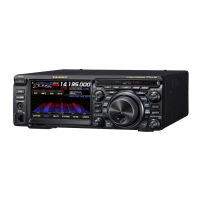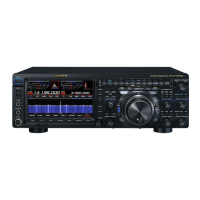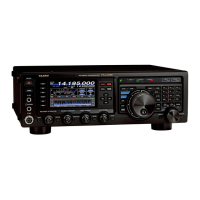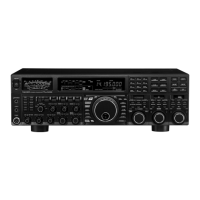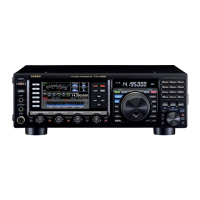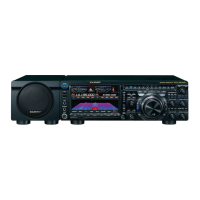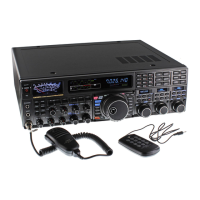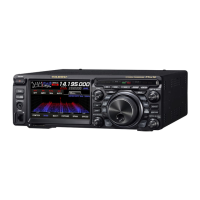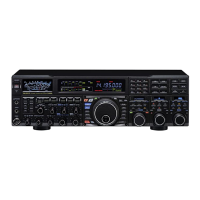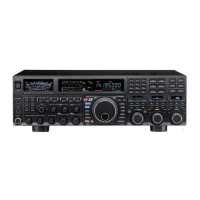Page 98 FTDX9000D OPERATION MANUAL
CONVENIENT TRANSMITTER ACCESSORIES
FULL DUPLEX OPERATION
The FTDX9000D includes a unique capability among HF
transceivers: the ability to operate in a full duplex envi-
ronment, where by you can transmit on the Main band
(VFO-A) while simultaneously tuning around, on a differ-
ent band, on the Sub band (VFO-B). This affords the con-
test operator extra tuning time in search of new contacts
and multipliers while calling CQ on the “run” band. This
yields “SO2R” (Single Operator, Two Radio) operating
capability while using only one transceiver!
To engage Full Duplex crossband operation, set Menu item
TX GNRL 158 (FULL DUP) to “DUP” instead of the
default "SIMP" selection. To return to normal (non-du-
plex) operation, return Menu #117 to SIMP.
When Full duplex operation is engaged, you may receive
on the Sub (VFO-B) band frequency while transmitting,
during dual receive operation, on a different band on the
Main band (VFO-A). This allows you to tune for contacts
on 15 meters, for example, while calling CQ on 20 meters
during a slow time in a contest. Press the Sub (VFO-B)
band “TX” Button/LED to switch transmit control to that
VFO to call a station, then press the Main (VFO-A) band
"TX" Button/LED to return to the “run” band and con-
tinue your “CQ” process.
This capability within a single transceiver is a unique fea-
ture of the FTDX9000. It relieves you of the need to run
separate key, PTT, and other control lines to two different
radios from your logging computer.
Note
Full Duplex operation within the same band (e.g. both Main
and Sub VFOs on 20 meters) is not possible.
Important Guidelines for Full Duplex Operation
Remember that, at your station location, the capability
exists for damaging RF voltage to be conducted from your
transmitting antenna into your receiving antenna during
full duplex operation. The exact amplitude will depend on
the operating frequency, proximity and polarization align-
ment of the antennas, and the transmitting power level (in-
cluding your linear amplifier, if used).
Accordingly, you should take some time, in assembling
your station, to ensure that proper isolation exists between
your station antenna systems. One way to do this is to con-
nect the “receive” antenna coaxial cable to the “Transmit-
ter” jack of low-power Wattmeter, and connect the “An-
tenna” jack of the Wattmeter to a 50-Ohm Dummy load.
Now transmit on the “TX” antenna you will be using, and
observe the deflection (if any) on the low-power Wattme-
ter connected to the “receive” antenna. For safe operation
of the FTDX9000, you should observe “10 mW” or less on
the Wattmeter.
Repeat this test for each band and antenna combination
that exists at your station. The low bands like 160 and 80
meters should be checked with particular care, as the physi-
cal sizes of antennas used on these bands can present very
high RF voltages to the front end of a receiver. Remember
to rotate directional antennas, and engage all “Upper” and
“Lower” combinations in Yagi stacks, so as to account for
different possibilities of mutual coupling between anten-
nas.
If excessive power is being induced onto the “Receive”
antenna, you will need to investigate and install suitable
bandpass filters and/or stubs in order to reduce the induced
power to a safe level. Suitable information may be found
in radio handbooks, and an excellent treatise is available
in the book “Managing Interstation Interference - Coaxial
Stubs and Filters” by George Cutsogeorge, W2VJN; in-
formation may be found at www.qth.com/inrad/book.htm.
The powerful CW operating capabilities of the FT DX
9000D include operation using both an electronic keyer
paddle and a “straight key” or emulation thereof, as is pro-
vided by a computer-based keying device.

